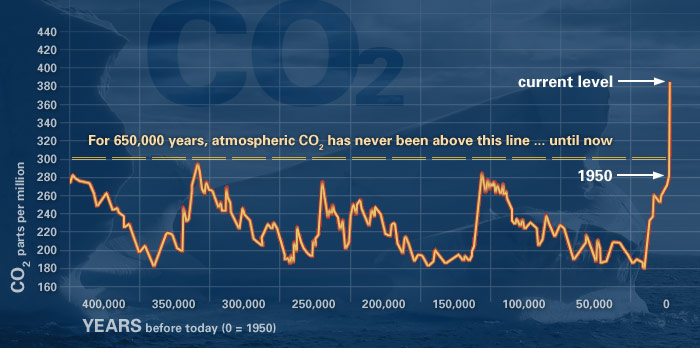| << Chapter < Page | Chapter >> Page > |

If we look even further back in time, over the last half million years, we see a similar story. (see Figure Evidence of Climate Change ) The current concentration of CO 2 in the earth’s atmosphere is higher than at any time in the past half million years. Where is this abundance of CO 2 coming from? Which reservoirs are being depleted of their CO 2 while the atmosphere takes on more? The answer lies in the burning of fossil fuels and in the deforestation of significant chunks of the earth’s forest biomes. Notice the spike in CO 2 concentrations beginning around 1750. This time period marks the beginning of the industrial revolution, when fossil fuels overtook wood as the primary energy source on our planet. Over the subsequent two and a half centuries, oil, coal, and natural gas have been extracted from their underground reservoirs and burned to generate electricity and power modern forms of transportation. The exhaust from this process is currently adding 30 billions of tons, or gigatons (Gt), of carbon dioxide to the atmosphere each year. Combine this addition of CO 2 , a known greenhouse gas, to the subtraction of one of the sinks of CO 2 through deforestation and the imbalance grows even further.

What is the end result? By examining the earth’s climate, both current and past and by investigating the three ways in which climate can change, we have arrived at the conclusion that the current warming is being caused by an imbalance in the carbon cycle that has been induced by human activity, namely the burning of fossil fuels. The record warmth over the last 1,300 years is very likely to have been caused by human decisions that have lead to a change in the chemistry of the atmosphere, and which has altered the natural climate variability toward warmer global temperatures. We are essentially changing the climate faster and in a different direction than natural processes have intended.
In Japan each spring millions of people celebrate the blossoming of the cherry trees to mark the arrival of warmer weather. These celebrations have a long and storied history, and records of the cherry blossom festivals date back more than a thousand years. In fact, the record of the timing of the cherry blossoms in Japan is the oldest for any flowering plant! Two scientists and historians. Richard Primack and Hiroyoshi Higuchi recently analyzed this record and found that beginning in the early 1800s the mean air temperature in March has slowly risen, similar to the increase shown in Figure Northern Hemisphere Surface Air . During this same time period, the flowering date has slowly crept earlier in the season, and the trees are now flowering several days before they traditionally flowered. Although urbanization of Japan has lead to an increase in temperature, recent climate change is blamed for the earlier flowering of the Japanese cherry blossom tree. Primack and Higuchi show how Kyoto has warmed an average of 3.4°C over the last 170 years. Climate change has contributed 18% to this total warming in Japan and Primack and Higuchi demonstrate the correlation of this warming with the industrial revolution.

Notification Switch
Would you like to follow the 'Sustainability: a comprehensive foundation' conversation and receive update notifications?